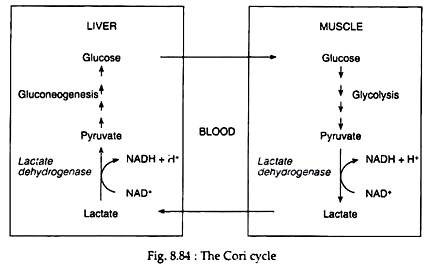The oxygen supply to the muscle in living vertebrate body under normal conditions is so efficient that it refrains lactic acid to accumulate. But during heavy exercise, the oxygen supply becomes inadequate, and excess of lactic acid accumulates in the muscle fibres and diffuses out into blood stream.
The reasons behind this, is the formation of NADH by glycolysis exceeds the ability of the respiratory chain to oxidize it back to NAD+. The pyruvate produced by glycolysis in muscle is then converted to lactate by Lactate dehydrogenase (LDH) (Fig. 8.84).
A considerable amount of blood lactate is utilised by the heart and small amounts by other tissues. But the major part of the blood lactate is taken up by the liver and is converted into glucose by gluconeogenesis. This glucose is released back into blood stream and reaches skeletal muscle and brain.
ADVERTISEMENTS:
In the muscle glucose is converted into glycogen by glycogenesis and thus muscle gains back its depleted glycogen store. Liver and muscle help each other to organise a bigger cycle through which lactic acid moves. This cycle is as follows: muscle glycogen → muscle lactic acid → blood lactate → liver glucose ↔ blood glucose → muscle glycogen. This cycle is called the Cori cycle.
